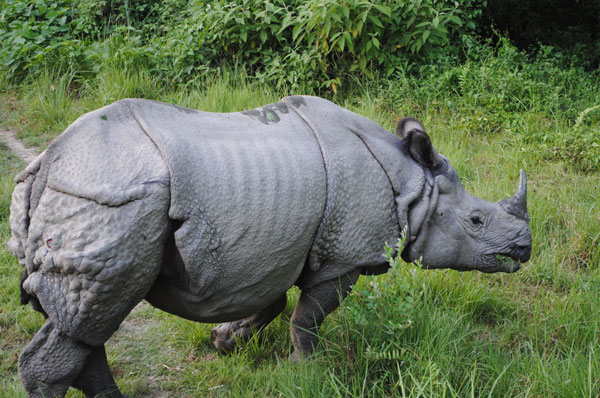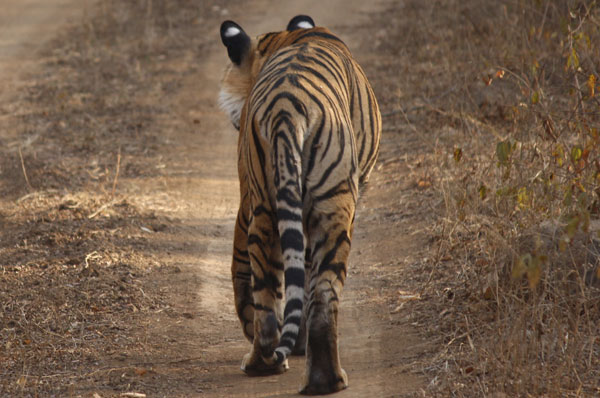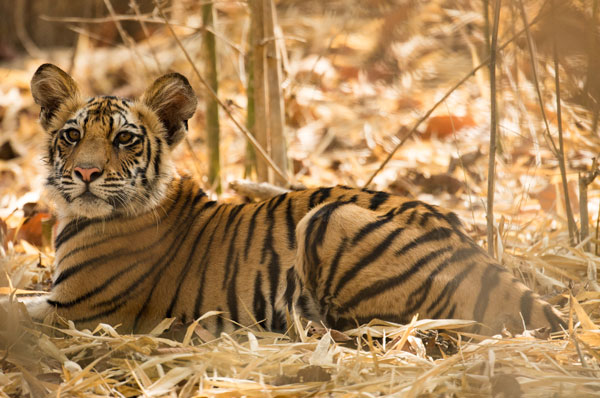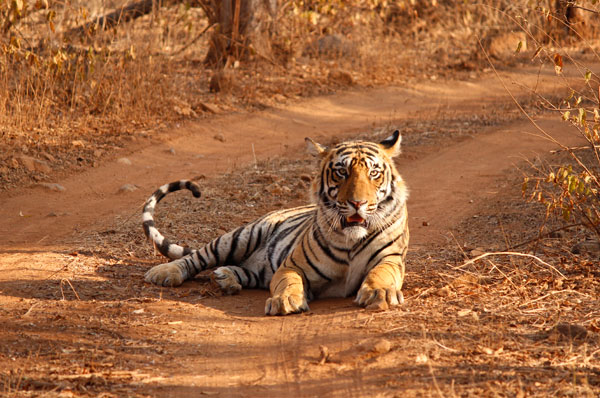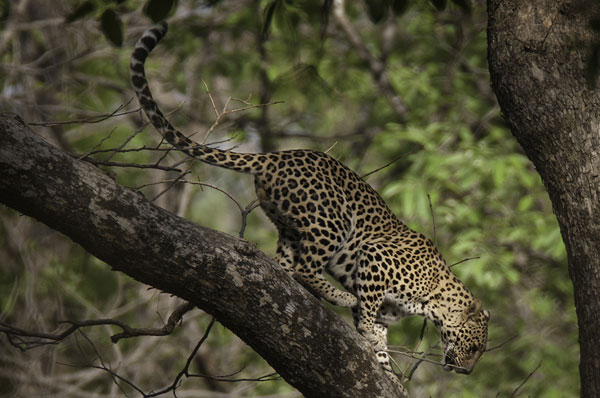Tiger Safaris in India
Ferocious, magnificent, mighty, agile, and royal. These words to justice to the powerful and fierce attitude of a Tiger. A tiger safari in India offers you a greatest chance to secure a wild encounter with the Royal Bengal Tiger. Be it the way it hunts down its prey, or when it roars mightily into the sky, witnessing a tiger in it’s full glory is certainly a spine-chilling experience! The desire to explore the wilderness of jungles has slowly started attracting more tourists towards jungle safaris over the years. And when it comes to authentic wildlife exploration, India has some of the best tiger reserves to offer as the setting of your safari. So which are the premium tiger reserves of India? What is the ideal time to visit them? What creatures can you get to capture with your camera? Read our Travel Guide to Tiger Safaris in India and find everything you need to know.
What makes India
the best tiger safari destination?
It will interest you to know that tigers were not only a part of many legends, but this mighty beast is also the national animal of India. The unaltered tropical forests of India, preserved in their pristine forms, are the natural dwellings of over 3890 tigers. Tiger safaris in India are not just about encountering the royal cats. It is about experiencing the wilderness of nature, appreciating the history and admiring nature’s treasures. With over 50 reserves, you have a lot of options to choose your favorite safari location based on its weather, surrounding scenic beauty, an abundance of flora and fauna, or heritage stays offered near the forest premises.
Tiger Population:
3,890+ Tigers
Home of around:
70% of the world’s tigers
# of Tiger Reserves in the Country:
63 Tiger Reserves
Diverse Wildlife:
India ia Among 17 mega bio-diverse countries
Forest Cover:
100s of National parks & 500+ wildlife sanctuaries
Project Tiger:
Success of a Wildlife Conservation Program
Amazing Facts
about Tiger Reserves in India:
- 1 About 80% of the world’s recorded population of tigers inhabit the Indian subcontinent. That is close to 3890 tigers.
- 2 As human activities like hunting and calamities like forest fires became frequent, tigers started losing their natural habitats, which further led to these species falling in the endangered category. Hence, the Indian Government initiated Project Tiger in 1973 for their protection and rehabilitation.
- 3 Before the declaration of Project Tiger, India had only 9 tiger reserves. However, the initiatives taken under this project have now increased the number to 50 tiger reserves throughout the country.
- 4 In addition to the existing ones, the Indian government plans to set up 4 more such reserves in the future.
- 5 It is said that a Bengal tiger’s roar is so loud, it can even be heard from 2 km away.
- 6 For many years the state of Madhya Pradesh housed the maximum number of tigers in India. However, a new report has declared that now it’s Sunderbans in West Bengal with the maximum count.
- 7 The mighty Bengal tiger is found in some states of India.
- 8 India has three Biosphere tiger reserves- Manas in Assam, Sunderbans in West Bengal, and Similipal in Orissa.
- 9 Manas Tiger Reserve of Assam was declared a World Heritage site, making it the only reserve with this title.
- 10 To provide a closer experience, some parks like Kaziranga, Jim Corbett, etc. also organize Elephant safaris.
11 Best National Parks
and Reserves for Tiger Safari in India:
With about 50 tiger reserves scattered over 19 states, narrowing in on the best reserve to visit becomes a tough choice. All reserves are well-maintained and offer unique wildlife adventures of their own. However, you got to pick one. So here are our top 11 picks for tiger safari in India and what all you can look forward to while visiting them.
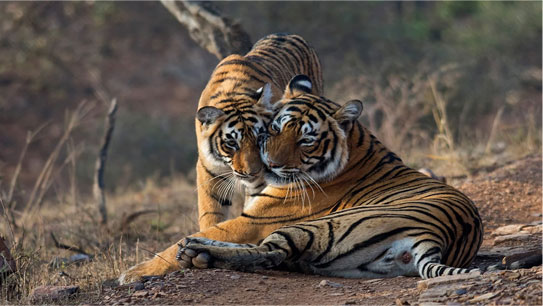
Ranthambore National Park
When it comes to naming the most renowned national park in India for tiger safari in India, the Ranthambore National Park in Rajasthan is always a popular choice. Once a prominent destination for the Rajput Maharajas of Jaipur where they occasionally came to hunt for pleasure, this site is now demarcated as a preserved region for tigers and other precious animals inhabiting the region.
It is estimated that the park houses close to 663 tigers, making the chance of spotting a tiger very high. Besides tigers, once can also come across hyenas, sloth bears, Indian foxes, panthers, and jackals. The three lakes present in the premises is said to be the habitat of many reptiles like crocodiles and snakes. The ruins of the historic Ranthambore Fort is a beloved resting spot for the tigers in summers and also serves as a decent point for photography. Set against the backdrop of the Aravalli range, Ranthambore National Park welcomes thousands of visitors every year. The resplendent surroundings and royal accommodations are what charms the aristocrats, making it one of the most visited reserves of the Indian subcontinent. Thus, Ranthambore National Park is certainly one of the finest places for Tiger safaris in India.
Read more about Ranthambore National Park
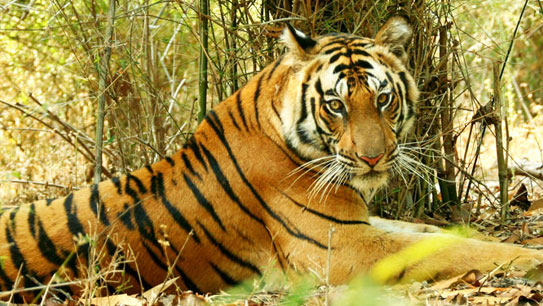
Bhandhavgarh National Park
In the wilderness of Vindhyan Range lies the Bandhavgarh National Park in Umaria district of Madhya Pradesh. Bandhavgarh was declared as a National Park in 1968, and this park occupies an area of about 105 sq. Km. The Bandhavgarh itself has a history that dates back to 2000 years ago, the place holding a very mythological significance. It is believed Bandhavgarh was gifted by Lord Rama to his younger brother Lakshmana and it is from here the place gets its name.
Thus, Bandhavgarh is a combination of two words; ‘Bandhav plus Garh,’ where Bandhav means brother and Garh mean Fort. So the name literally means ‘brother’s fort.’ Bandhavgarh is also the land of tigers. The National Park has the highest density of 526 Bengal Royal Tiger in the world; the sight will be total majestic and thrill in itself to spot a big cat. Bandhavgarh National Park also includes tall grasslands and thick sal forests. This National Park has three major zone demarcations namely-Tala, Camera, and Magdi. Magdi is a transitional zone where tourists get the opportunity of spotting the Royal tiger and some other animals like Elephants, Langurs, Bison, and Cheetals. The ideal time to visit and explore this place in January to March.
Read more about Bandhavgarh National Park
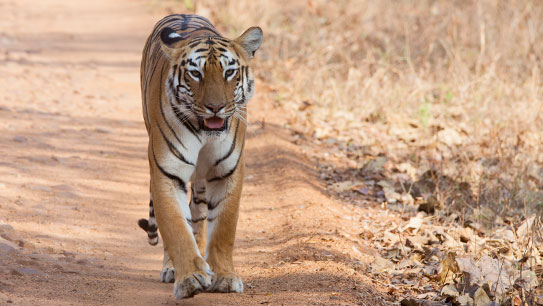
Tadoba Andhari National Park
Wild ambience blended with tropical climate make Tadoba National park ideal destination for wildlife safari lovers. Tadoba National park also known as “Tadoba Tiger Reserve” is oldest and largest National park of Maharashtra set up in year 1955 with the total area of 1727sq.km. The Park resides in the Chandrapur district of Maharashtra state and is approximately 150 km away from Nagpur city. The name has been bestowed by local tribal people “Tadpna” or “Taru” from the local god they worship and “Andheri” from the regional river that flows in the area. The National Park primarily focuses on boosting tiger population. A total of about 46 tiger populations inhabit in the National park.
With the endless richness of resources (I.e., flora and fauna) one can come across- Indian Mouse Deer, Ratel, Sambar, Wild Pig, Spotted Deer, Flying Squirrel, Four Horned Antelope. This place attracts a huge number of tourists over a year. For adventure lover gypsy and jeep safari are always an option. The best period to plan your tiger safari tour in Tadoba would be from January to March and treat yourself with thrill and adventure.
Read more about Tadoba Andhari National Park
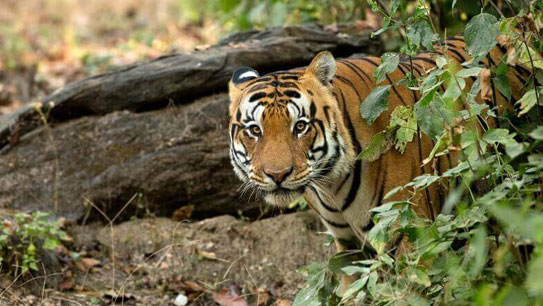
Kahna Tiger Reserve
When it comes to a wide variety of wildlife, Madhya Pradesh tops the list, and the tiger reserve of Kanha is amongst them. Perched in the very pristine Maikal Range of Satpura, this reserve lies in Central India. Prominent as one of the finest tiger reserves in India, it offers travelers and wildlife enthusiasts multiple attractions to venture into this place.
 When it comes to a wide variety of wildlife, Madhya Pradesh tops the list, and the tiger reserve of Kanha is amongst them. Perched in the very pristine Maikal Range of Satpura, this reserve lies in Central India. Prominent as one of the finest tiger reserves in India, it offers travelers and wildlife enthusiasts multiple attractions to venture into this place. Declared as reserved and protected area in 1879, it was finally positioned as National park in 1955. The park occupies an area of 940 sq. Km.
When it comes to a wide variety of wildlife, Madhya Pradesh tops the list, and the tiger reserve of Kanha is amongst them. Perched in the very pristine Maikal Range of Satpura, this reserve lies in Central India. Prominent as one of the finest tiger reserves in India, it offers travelers and wildlife enthusiasts multiple attractions to venture into this place. Declared as reserved and protected area in 1879, it was finally positioned as National park in 1955. The park occupies an area of 940 sq. Km.
Fresh breeze from the woods, the setting of these jungles inspired writings like Rudyard Kipling’s story titled “The Jungle Book.” The stunning sunset and sunrise gazing points like “Bamni Dadar” are further some interesting worth doing things in the park. Besides tiger population the park has quite a good number of population of the Indian leopard, the sloth bear, barasingha, and Wild dog. To get the best out of this place, one must visit this national park in the season of February to June.
Read more about Kanha National Park
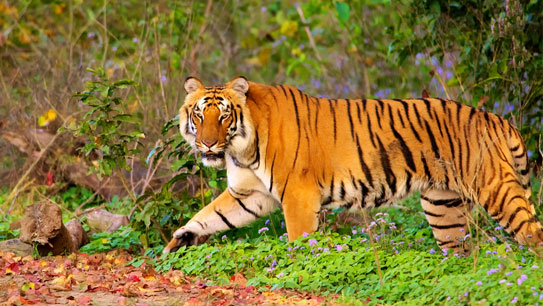
Jim Corbett National Park
“My wish is to stay always like this, living quietly in a beautiful corner of nature.” These lines well suit the vibes you get as soon as you enter Jim Corbett National Park. Situated in the magical landscape of sub-Himalayan belt in Nainital District, this reserve is an eminent tourist attraction for wildlife lovers all over the world.
 “My wish is to stay always like this, living quietly in a beautiful corner of nature.” These lines well suit the vibes you get as soon as you enter Jim Corbett National Park. Situated in the magical landscape of sub-Himalayan belt in Nainital District, this reserve is an eminent tourist attraction of Uttrakhand. In the beginning years (1936) this park was known as Hailey National park, which was changed to Jim Corbett in the later years to honor the author and naturalist Jim Corbett whose work and initiatives helped reserving the Bengal tigers in the 1900s.
“My wish is to stay always like this, living quietly in a beautiful corner of nature.” These lines well suit the vibes you get as soon as you enter Jim Corbett National Park. Situated in the magical landscape of sub-Himalayan belt in Nainital District, this reserve is an eminent tourist attraction of Uttrakhand. In the beginning years (1936) this park was known as Hailey National park, which was changed to Jim Corbett in the later years to honor the author and naturalist Jim Corbett whose work and initiatives helped reserving the Bengal tigers in the 1900s.
Corbett National Park occupies an area of 520.8 sq.km, which includes so much varied landscape features likes hills, marshy depression, riverine belts, and large lakes. This is amongst the few national parks that allow luxurious accommodation during night in the middle of the forest. Shielding the big wild cat from poaching and other encroachment activities is the need of hour for ecological balance. Enjoy nature as the bloom of spring and the fall of winter and soak yourself in it. Jim Corbett park is one of the best places for tiger safaris in India.
Read more about Jim Corbett National Park
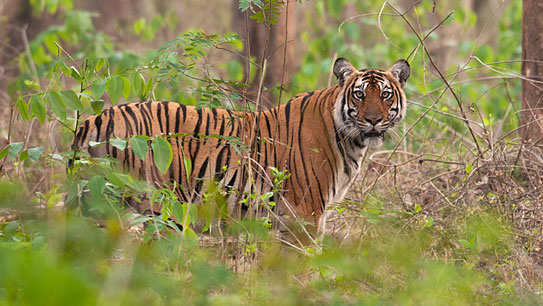
Nagarhole National Park and Tiger Reserve
The sweet aroma of rosewood and sandalwood trees fill the air as you stroll through the forests of Nagarhole National Park. Named as a tiger reserve in 1999, this park was officially known as Rajiv Gandhi National Park.
 The sweet aroma of rosewood and sandalwood trees fill the air as you stroll through the forests of Nagarhole National Park. Named as a tiger reserve in 1999, this park was officially known as Rajiv Gandhi National Park. It lies in Kodagu district of Karnataka. It shares its boundaries with Bandipur National Park, with the River Kabini separating their areas. The dry deciduous vegetation hides a few freshwater swamps amid its rich flora. The reserve is a part of Nilgiri Biosphere Reserve, making it a hotspot for extraordinary biodiversity.
The sweet aroma of rosewood and sandalwood trees fill the air as you stroll through the forests of Nagarhole National Park. Named as a tiger reserve in 1999, this park was officially known as Rajiv Gandhi National Park. It lies in Kodagu district of Karnataka. It shares its boundaries with Bandipur National Park, with the River Kabini separating their areas. The dry deciduous vegetation hides a few freshwater swamps amid its rich flora. The reserve is a part of Nilgiri Biosphere Reserve, making it a hotspot for extraordinary biodiversity.
With a Bengal tiger population close to 101, Nagarhole is home to many ferocious predators like Indian leopard, striped hyena, Ussuri dhole, wild boar, etc. However, you can also spot amicable deer and lively elephants roaming freely. Porcupines, flying squirrel, and slender loris are hard to find and require a sharp eye. From mammals to reptiles, and from birds to insects, all are present in the ethereal terrain of Bandipur reserve. Besides safari rides, you can also feel your adrenaline rush by participating in white water rappelling and boating in Kabini river or trek up to the Irupu waterfalls. If you are seeking a perfect location for tiger safaris in India, then Nagarhole National Park and Tiger Reserve would be a perfect choice.
Read more about Nagarhole National Park
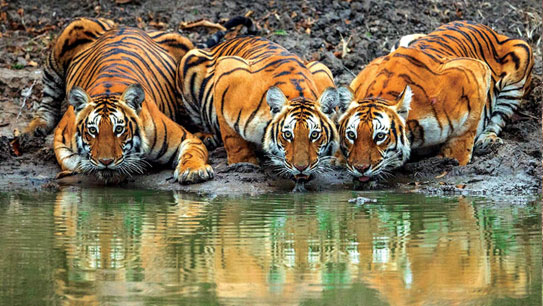
Bandipur National Park
Many years ago, the royal families of Mysore kingdom used to visit these broad-leaf deciduous forests when they went on hunting expeditions.
 Many years ago, the royal families of Mysore kingdom used to visit these broad-leaf deciduous forests when they went on hunting expeditions. And it was in 1973 when the Ministry of Environment and Forests demarcated this region as Bandipur National Park. Since then, this national reserve has protected the endangered and vulnerable species in its habitat.
Many years ago, the royal families of Mysore kingdom used to visit these broad-leaf deciduous forests when they went on hunting expeditions. And it was in 1973 when the Ministry of Environment and Forests demarcated this region as Bandipur National Park. Since then, this national reserve has protected the endangered and vulnerable species in its habitat.
It has the largest population of wild elephants in Asia and the second largest population of tigers in India. Located in Chamarajanagar district of Madhya Pradesh, the topical jungles and shrublands are dwellings of a variety of fauna. From giant elephants and bison to fierce tigers and leopards, from agile antelopes and deer to reptiles like cobra and python, the diversity of Bandipur is admired by wildlife enthusiasts and birdwatchers. Kabini, Moyar and Nugu rivers run through the forest, providing ample opportunities for water sports like river rafting and water rappelling.
Read more about Bandipur National Park
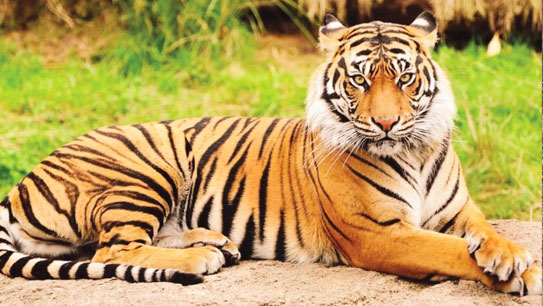
Kaziranga National Park
Adored for the unparalleled beauty of its bewitching landscape, Kaziranga National Park is one of the most charismatic wildlife reserves in the Indian subcontinent and also an ideal place for tiger safaris in India. Surrounded by the aromatic tea plantations of Assam, this national park is the abode of the world’s largest one-horned rhinoceros.
 Adored for the unparalleled beauty of its bewitching landscape, Kaziranga National Park is one of the most charismatic wildlife reserves in the Indian subcontinent and also an ideal place for tiger safaris in India. Surrounded by the aromatic tea plantations of Assam, this national park is the abode of the world’s largest one-horned rhinoceros.
Adored for the unparalleled beauty of its bewitching landscape, Kaziranga National Park is one of the most charismatic wildlife reserves in the Indian subcontinent and also an ideal place for tiger safaris in India. Surrounded by the aromatic tea plantations of Assam, this national park is the abode of the world’s largest one-horned rhinoceros.
These fascinating animals are present in such abundance that you’ll spot a rhinoceros lazily crossing your road while you are on your safari. Apart from 2413 rhinos that roam in this region, the tiger population of this reserve is about 104. Sub-tropical broadleaf forests, tall savanna grasslands, and marshes constitute the diverse terrain of the reserve. The four rivers and petit streams flowing through the entire region make it an eminent biodiversity hotspot. As a fact, UNESCO even declared Kaziranga National Park a world heritage in 1985.
Giant water bodies located in the region are occasional resting spots for Asiatic water buffalos, one-horned rhinos, Royal Bengal tigers, Indian bison, leopards, Indian civets, and many more animals. Visitors also love taking bumpy elephant rides. From sambar and eastern swamp deer to Indian muntjac, you can spot a variety of deer here. The pleasant weather lasts for a major part of the year, hence the park witnesses crowds of nature enthusiasts every season.
Read more about Kaziranga National Park
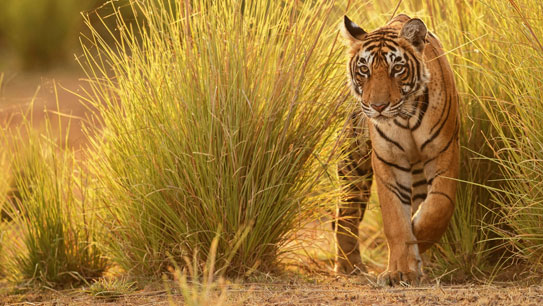
Pench National Park
Pench National Park is one of the remarkable tiger reserves of India. Most of us have already read about its ethereal beauty, as this is the jungle that Mowgli was lost in and raised as a child in the story “The Jungle Book’ by Rudyard Kipling. Located in the foothills of Satpura range, this reserve is shared by the states of Madhya Pradesh and Maharashtra. However, the major part lies in the former state.
 Pench National Park is one of the remarkable tiger reserves of India. Most of us have already read about its ethereal beauty, as this is the jungle that Mowgli was lost in and raised as a child in the story “The Jungle Book’ by Rudyard Kipling.
Pench National Park is one of the remarkable tiger reserves of India. Most of us have already read about its ethereal beauty, as this is the jungle that Mowgli was lost in and raised as a child in the story “The Jungle Book’ by Rudyard Kipling.
Located in the foothills of Satpura range, this reserve is shared by the states of Madhya Pradesh and Maharashtra. However, the major part lies in the former state. The park got its name from River Pench. Gushing down from Mahadeo Hills, Pench River divides into small brooks that encompass the entire jungle. Its sparkling water is the lifeline of all creatures living peacefully in reserve, and hence, this is a popular spot for encountering both prey and predators. The deciduous forests cover its topography and are the dwellings of many animal species.
It has close to 48 tigers, with the fierce Bengal tiger in the attendance too. Apart from this, you can also locate animals like wolves, Indian leopard, small Indian civet, wild pig, ruddy mongoose, black-nape hare, and rhesus macaque. Hikers also enjoy trekking on the adjacent hills of Satpura range. The park remains closed for visitors in monsoon season.
Read more about Pench National Park
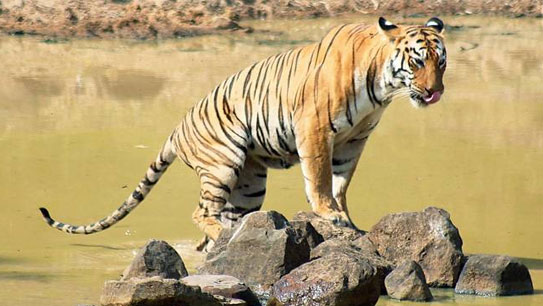
Panna National Park
Resting on the verdant greenery of Vindhyachal range, Panna National Park of Madhya Pradesh is cherished for its natural vistas hosting an abundance of wildlife. The entire reserve encompasses an area of 543 sq. Km. It spreads across the districts of Panna and Chattarpur.
 Resting on the verdant greenery of Vindhyachal range, Panna National Park of Madhya Pradesh is cherished for its natural vistas hosting an abundance of wildlife. The entire reserve encompasses an area of 543 sq. Km. It spreads across the districts of Panna and Chattarpur. Little springs of water fill the terrain of this national park that equally attracts the tourists and wildlife of the region.
Resting on the verdant greenery of Vindhyachal range, Panna National Park of Madhya Pradesh is cherished for its natural vistas hosting an abundance of wildlife. The entire reserve encompasses an area of 543 sq. Km. It spreads across the districts of Panna and Chattarpur. Little springs of water fill the terrain of this national park that equally attracts the tourists and wildlife of the region.
A popular tourist spot is the gushing River Ken, the source of many gorges and falls across the reserve. River Ken runs through the park and reptiles like crocodiles resting beneath its surface. There are small waterfalls, where the chances of spotting the creatures become high. One such waterfall is the Pandav Falls. This gigantic fall amidst the thick trees is a picturesque sight and is a photographer’s paradise. On your expedition, you’ll also come across ancient ruins and caves. The renowned city of Khajuraho is also very close at hand. As per the census, only 17 tigers are roaming in these jungles.
However, this is compensated by the diverse species of flora and fauna that you can encounter. Birdwatchers are in for a treat as they can spot rare and indigenous species of birds here. You can spot deadly predators like hyenas, wolf, and leopards. And you can also spot rock python, nilgai, sloth bear, and chital deer. Thus, Panna National Park should be in your bucket list for mesmerizing tiger safaris in India.
Read more about Panna National Park
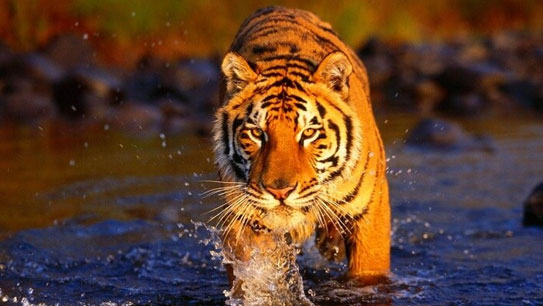
Sariska Tiger Reserve
Another popular name in the list of national parks in the tiger reserve of Sariska. Located in the Alwar district of Rajasthan, this was formerly a hunting ground before being declared a wildlife reserve in 1990.
 Another popular name in the list of national parks in the tiger reserve of Sariska. Located in the Alwar district of Rajasthan, this was formerly a hunting ground before being declared a wildlife reserve in 1990. Hills of the Aravalli range overlooks the dry grasslands, scrub-thorn bushes and rocky terrain that together form the panorama of its deciduous forests. Covering an area of roughly 274 sq. km, this reserve was the first relocation project for Bengal tigers and now is home to 22 such majestic cats of the wild.
Another popular name in the list of national parks in the tiger reserve of Sariska. Located in the Alwar district of Rajasthan, this was formerly a hunting ground before being declared a wildlife reserve in 1990. Hills of the Aravalli range overlooks the dry grasslands, scrub-thorn bushes and rocky terrain that together form the panorama of its deciduous forests. Covering an area of roughly 274 sq. km, this reserve was the first relocation project for Bengal tigers and now is home to 22 such majestic cats of the wild.
Nature lovers take delight in visiting Sariska Tiger Reserve because of its flourishing flora and wildlife safari in India. Some of the anticipated animals in this area are the golden jackal, sambar and chital deer, nilgai, Indian leopard, wild boar, and Indian hare. Right in the heart of its jungle, there is the elegant Kankarwadi Fort. The top of the fort allows skyline views of the forest, as well as chances of spotting the treasured bird species. You can also watch crocodiles lying near the banks of Siliserh Lake, or click pictures near the ancient remains of temples belonging to the medieval times. The tropical weather during the summer season makes it hard to enjoy safari rides, so it is preferred to witness enthralling tiger safaris in India at Sariska tiger reserve, in the colder months of October, November, and December.
Read more about Sariska National Park
 Looking to book a Safari in Tiger Safari India ? Our wildlife experts are here to help.
Looking to book a Safari in Tiger Safari India ? Our wildlife experts are here to help.
When is the
Best Time to see Tigers in India?
Pointing out the best months for tiger safaris in India is tough. Wildlife lovers who wish to get close encounters with the mighty beasts in their natural habitats prefer to come during the drier months from February to June. The soaring temperatures and thescorching heat depletes the water of pools and lakes. The grass and trees dry due to shriveling, making the landscape look parched and desert-like. Thirst drives these tigers out of their homes to roam in search of water and rest in the proximity of the remaining pools. Hence, the chances of spotting tigers become maximum. And you also get plenty of opportunities to photograph wildlife so near at hand.
However, the hot climate makes it equally uncomfortable to travel. So for a breezy atmosphere, some travelers prefer coming after the monsoon months of August and September. The showers of the rainy season restore the green in the jungle. The grasslands become taller, making it hard to spot to find tigers, and at the same time, increasing the adventure. Also, the cool weather makes traveling a lot easier.
FAQs for Tiger Safari in India
Tigers can adapt to a variety of climatic conditions, hence are found in about 19 states of India. As per the latest census, the states of Madhya Pradesh and Karnataka are home to around 526 tigers each. Next in line is Uttarakhand, with over 442 tigers in its jungles.
Spreading across five districts, with a total area of more than 3700 sq. Km is Nagarjunsagar-Srisailam Tiger Reserve. This tiger reserve lies in the states of Andhra Pradesh and Telangana, marking it as the biggest tiger reserve in the subcontinent.
Established in 1936, Jim Corbett National Park is the oldest natural reserve for tigers in India. The sanctuary is situated in the Nainital district of the hilly state of Uttarakhand. It was named after the British naturalist Jim Corbett, who did a lot of work towards its formation.
The pristine jungles of India are home to a diverse range of wildlife species. So on your trip to the national parks, you can expect to find a lot of fascinating creatures like elephants, peacocks, deer, one-horned rhinoceros, striped hyenas, leopards, Indian fox, golden jackal, red-headed vulture, mongoose, and hedgehogs to name a few.
Due to their rare pale fur, the white tigers slowly became a threatened species and were captured from the wild to be bred in captivity. They can now be found in selected zoos only.
There are 50 tiger reserves in India which are looked upon by the National Tiger Conservation Authority in India ( NTCA).
The best time to visit Jim Corbett park would be in the winters between the months of November and February. At this time of the year, Tigers along with other animals tend to be less vulnerable as well.
Why should you go for a Tiger Safari in India?
You should go for a Tiger Safari in India because:
- It would be a jaw-dropping adventure, which would be embedded in your memories forever.
- It would give you insights of the wildlife heritage in India.
- It would fascinate you to explore more about the wildlife.
- It would be an ideal trip for you vacations.
- It would also feature some of the most rare wildlife species as well.
Tiger Safari in India is not ideal for you, if-
- You are not fascinated by the glorious wildlife.
- You are faint-hearted, as it might cause adverse affects to your health.
- You can’t bear the humid temperatures of India
- You are not equipped with ideal accessories like hats and sunglasses.
Tiger Safari Tips
- 1 The wild cannot be controlled. Hence, safety becomes a huge responsibility when going on a safari. So listen carefully to the instructions given by your tour guide.
- 2 To strengthen your chances of spotting a tiger, stay calm, and be quiet. Do not make any sounds that can startle the animal and make it run away.
- 3 Always keep this in mind that these are wild creatures roaming in their natural habitats. So don’t lose heart if you don’t get to see a tiger. Instead, try taking in the whole experience of being close to nature. Watch the other animals rest peacefully, photograph the enchanting beauty of the forests, and enjoy your bumpy ride in the jungle.
- 4 When traveling in the hotter months, carry sunglasses, hats, and sunscreen. Drink plenty of liquids to stay hydrated.
- 5 Mosquito bites are frequent when promenading through the jungle. So apply plenty of mosquito repellants before the safari to avoid the risk of malaria and dengue. Sleep under mosquito nets in the night to prevent.
- 6 Carry a small medical kit with necessary supplements for common problems.
- 7 Watch out for wild snakes. In case of a snake bite, report to the nearest medical facility immediately.
Popular Routes for Tiger Safari in India
Dudhwa National Park tours offer in the Dudhwa wildlife sanctuary, Dudhwa Tiger Reserve, National Park in ...
Golden Triangle with Tiger Tour is a best Jungle Tours to India. Book a Tours to Indian Jungle and enjoy ...
Taj Mahal and Tiger Tour is a famous Tiger Safari in India. Book Tiger Tours in India and enjoy Wildlife ...
Taj Mahal and the tale of Tiger Tour is a famous Tiger Safari in India. Book Tiger Tours in India and enj ...
Ranthambhore National Park Weekend Getaway is a short-term wildlife safari in India. You can see the high ...
Sariska Wildlife Sanctuary Weekend Getaway is a short-term wildlife safari in India. You can see the high ...
royal bangal tiger taj khajuraho is a famous Tiger Safaris in India. Book Tiger Tours in India and enjoy ...

